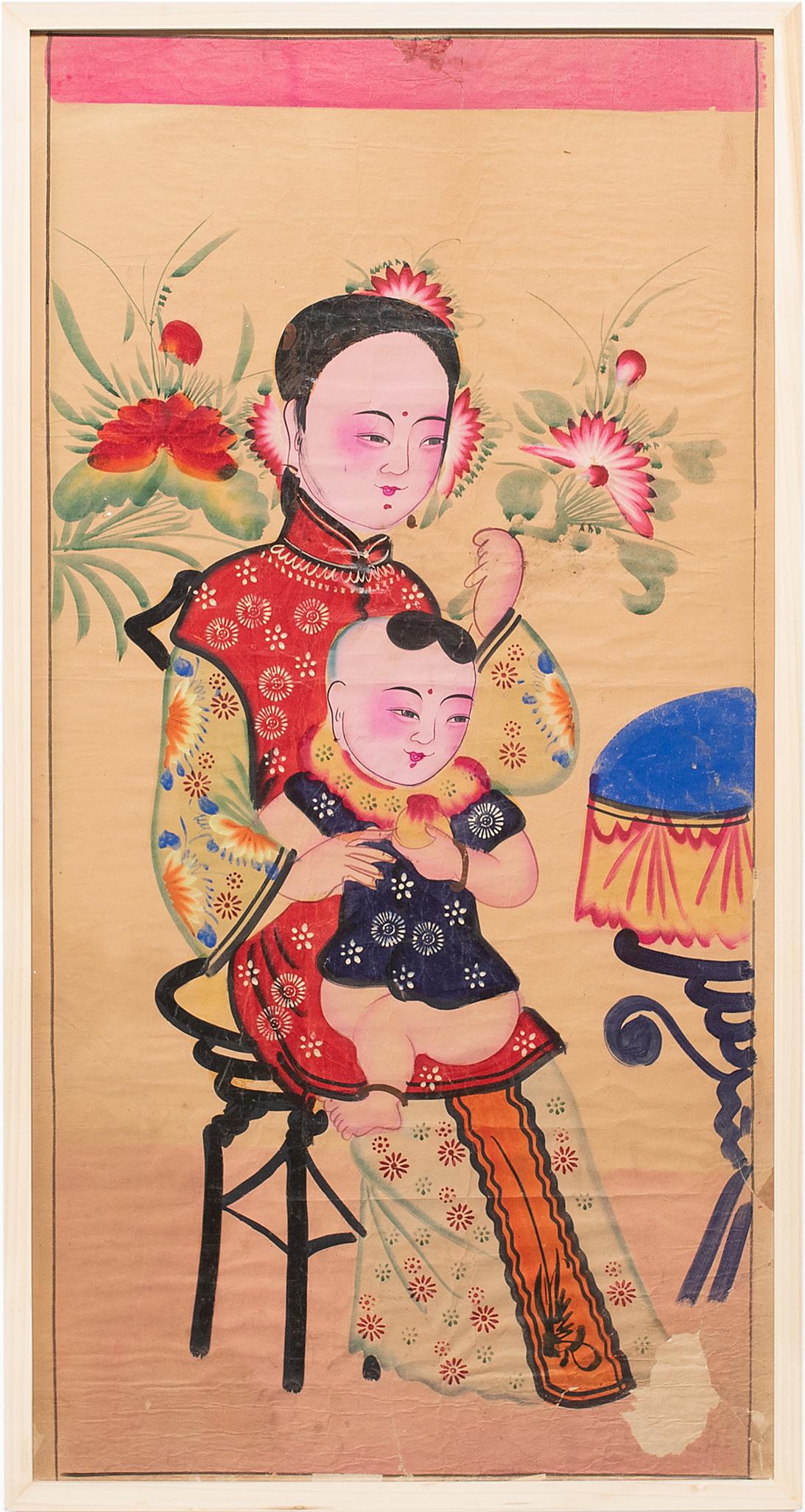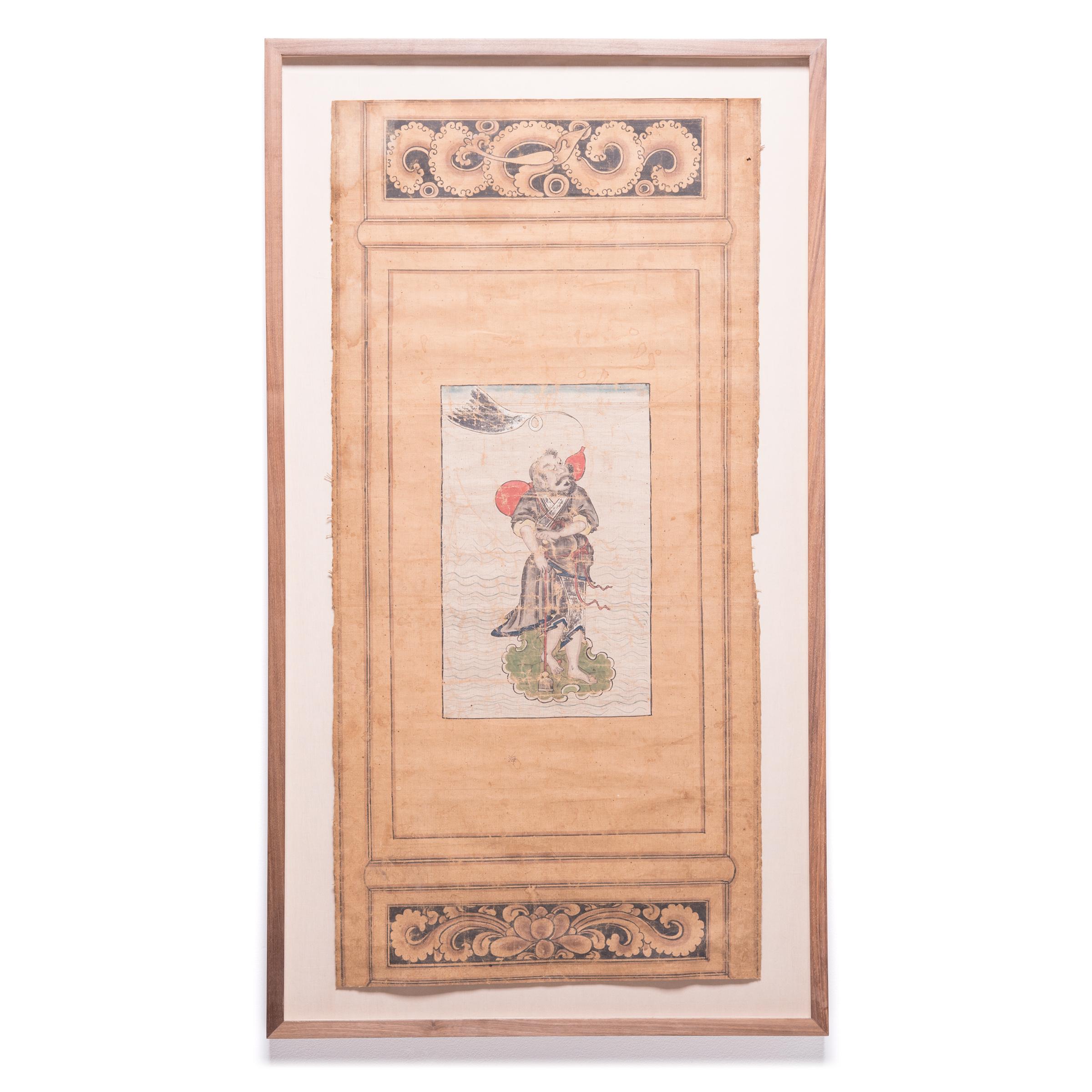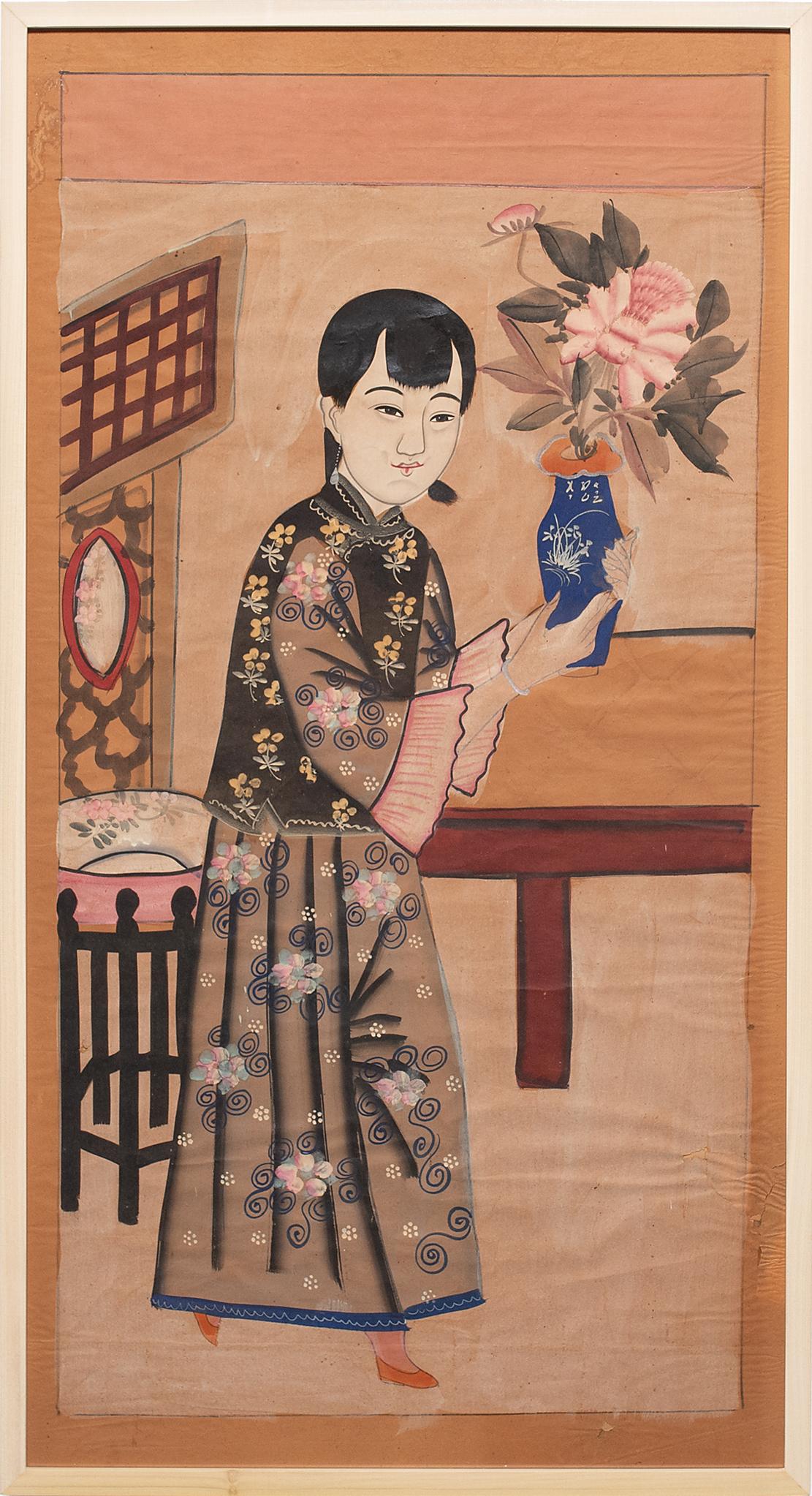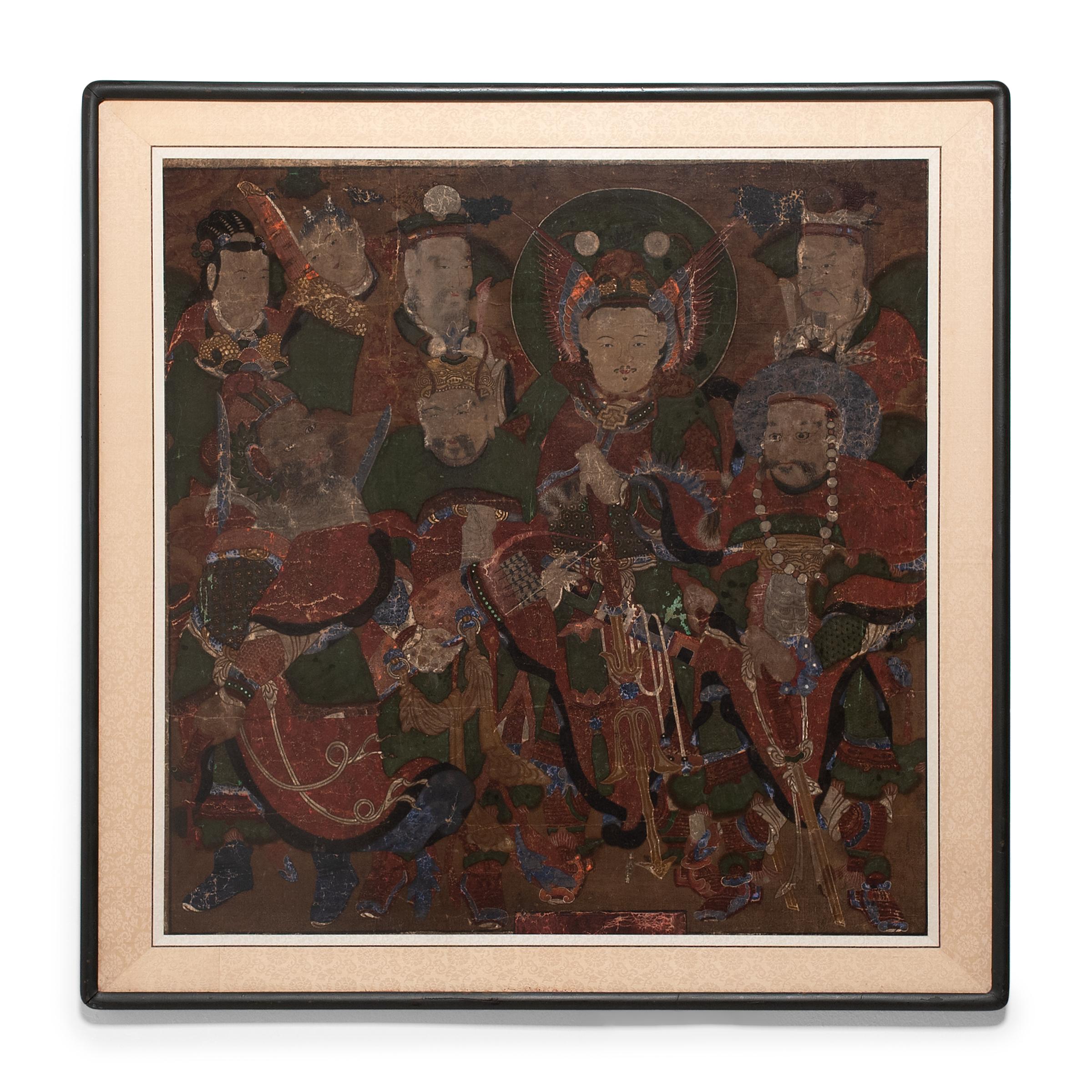Items Similar to Miniatures with Text from the "Legend of Phra Malai"
Want more images or videos?
Request additional images or videos from the seller
1 of 9
UnknownMiniatures with Text from the "Legend of Phra Malai"
About the Item
Unknown Artist, Thailand, 19th century
Miniatures with Text from the "Legend of Phra Malai"
Double folio; ink, color and gold leaf, c. 1900
Unsigned
Script: Khmer (Cambodian) These texts are written in Khom script, a variant of Khmer script often used in Central Thai religious manuscripts.
Paired devas (lesser gods) on throne-like plinths addorse Khmer (Cambodian) script containing tales of Phra Malai, a Sri Lankan arhat or Buddhist saint known for his travels to hell. There, the compassionate monk gave teachings and comfort to sufferers. Phra Malai stories taught the karmic effects of human actions to the faithful as well as conveying Maitreya's message of hope for attaining nirvana.
Though known in neighboring countries, the stories of Phra Malai achieved their greatest popularity and influence in Siam (present day Thailand)
Condition: Very good
Sight window) size: 11-1/8 x 27 inches
Frame size: 19-5/8 x 34-7/8 x 3/4 inches
The legend of Phra Malai, a Buddhist monk of the Theravada tradition said to have attained supernatural powers through his accumulated merit and meditation, is the main text in this 19th-century Thai samut khoi (folding book) held in the Thai, Lao, and Cambodian Collections of the British Library. Phra Malai figures prominently in Thai art, religious treatises, and rituals associated with the afterlife, and the story is one of the most popular subjects of 19th-century illustrated Thai manuscripts. The earliest surviving examples of Phra Malai manuscripts date back to the late 18th century, although it is assumed that the story is much older, being based on a Pali text. The legend also has some parallels with the Ksitigarbha Sutra. The Thai text in this manuscript is combined with extracts in Pali from the Abhidhammapitaka, Vinayapitaka, Suttantapitaka, Sahassanaya, and illustrations from the Thotsachat (Last ten birth tales of the Buddha). Altogether, the manuscript has 95 folios with illustrations on 17 folios.
- Dimensions:Height: 11.13 in (28.28 cm)Width: 27 in (68.58 cm)
- Medium:
- Period:
- Condition:
- Gallery Location:Fairlawn, OH
- Reference Number:
About the Seller
5.0
Recognized Seller
These prestigious sellers are industry leaders and represent the highest echelon for item quality and design.
Platinum Seller
These expertly vetted sellers are 1stDibs' most experienced sellers and are rated highest by our customers.
Established in 1978
1stDibs seller since 2013
711 sales on 1stDibs
Typical response time: 1 hour
Associations
International Fine Print Dealers Association
- ShippingRetrieving quote...Ships From: Akron, OH
- Return PolicyA return for this item may be initiated within 10 days of delivery.
More From This SellerView All
- The Dark Aspect of the Great Goddess DeviLocated in Fairlawn, OHThe Dark Aspect of the Great Goddess Devi Pigment on paper (unfinished), 19th century Unsigned as is usual Condition: Good color Voids at edges of the sheet Image s...Category
19th Century Rajput Figurative Drawings and Watercolors
MaterialsPigment
- Two Miniatures and text from the "Legend of Phra Malai"Located in Fairlawn, OHUnknown Artist, Thailand, 19th century Two Miniatures and text from the "Legend of Phra Malai" Ink and color on paper, c, 1900 Unsigned as usual Script: Aksar Chrieng or Khmer These texts are written in Khom script, a variant of Khmer script often used in Central Thai religious manuscripts. Phra Malai was a Budhist monk whose meditations permitted him to travel to heaven and hell. Condition: Good, with minor staining to text Sight (window) size: 11-1/8 x 27 inches Frame size: 19-3/4 x 35 x 3/4 inches Framed in solid cherry wood with archival, acid free materials The legend of Phra Malai, a Buddhist monk of the Theravada tradition said to have attained supernatural powers through his accumulated merit and meditation, is the main text in this 19th-century Thai samut khoi (folding book) held in the Thai, Lao, and Cambodian Collections of the British Library. Phra Malai figures prominently in Thai art...Category
19th Century Other Art Style Figurative Drawings and Watercolors
MaterialsPigment
- Double sided crayon drawing in colors: Study for "The Shoe" (recto)By Théophile Alexandre SteinlenLocated in Fairlawn, OHDouble sided crayon drawing: Front: Study for "The Shoe" Reverse: Studies of Figures Blue crayon, red and black crayons Image size: 19.25 x 15.375 inches Frame size: 30 x 25 1/2 inches Signed with the estate stamp, Lugt 2312b, recto and verso Annotated on verso in blue pencil: “On Demande des petites femmes...Category
1890s Art Nouveau Figurative Drawings and Watercolors
MaterialsCrayon
- Two Boys (one standing, the other seated and drawing)By Mary SpainLocated in Fairlawn, OHTwo Boys (one standing, the other seated and drawing) Graphite and colored pencils on wove paper, 1975 Signed and dated lower left center (see photo) Condition: Excellent Slight waviness visible only on reverse Image size: 11 1/2 x 13 3/4 inches Sheet size: 14 x 17 3/4 inches Provenance: Estate of the Artist By descent Mary Spain (Colie) (1934-1983) Mary Spain was born in Raleigh, North Carolina. She taught art in Chagrin Falls...Category
1970s Contemporary Figurative Drawings and Watercolors
MaterialsColor Pencil
- Sketch of a woman's head in profileBy Sir William OrpenLocated in Fairlawn, OHSketch of a woman's head in profile Graphite on paper, c. 1900-1910 Unsigned Condition: Excellent Tiny tear upper right near hinge (repaired and bearly visible) Sheet size: 4 5/8 x 3...Category
1910s Impressionist Figurative Drawings and Watercolors
MaterialsGraphite
- Preliminary Study for the painting Rose and Gold, 1913By William McGregor PaxtonLocated in Fairlawn, OHPreliminary Study for the painting Rose and Gold, 1913 Graphite on paper, 1913 Signed in pencil lower left (see photo) Titlted "Lizzy Young" in pencil upper left (see photo) Lizzy was a modle that Paxton depicts numerous times. The painting that this drawing is related to, is illustrated in Lee & Krause, William McGregor Paxton, 1869-1941, Plate 32, text on page 132. The painting was formerly in the collection of Victor Spark and the Honorable Paul Buchanan. It is currently in a Texas Collection. Provenance: Private Collection, Florida William McGregor Paxton (June 22, 1869 – 1941) was an American painter and instructor who embraced the Boston School paradigm and was a co-founder of The Guild of Boston Artists. He taught briefly while a student at Cowles Art School, where he met his wife Elizabeth Okie Paxton, and at the Museum of Fine Arts School in Boston. Paxton is known for his portraits, including those of two presidents—Grover Cleveland and Calvin Coolidge—and interior scenes with women, including his wife. His works are in many museums in the United States. Early life He was born on June 22, 1869, in Baltimore to James and Rose Doherty Paxton. William's father moved the Paxton family and established a catering business in Newton Corner, Massachusetts, in the mid-1870s. Education Paxton attended Cowles Art School on a scholarship he attained at the age of 18. He studied with Dennis Miller Bunker...Category
1910s American Impressionist Figurative Drawings and Watercolors
MaterialsGraphite
You May Also Like
- Yangliuqing Longevity New Year Painting, c. 1920Located in Chicago, ILChinese New Year paintings (nian hua) are colorful folk paintings created to celebrate the annual Spring Festival. Drawn or printed by folk artists in regional studios, nian hua pain...Category
Early 20th Century Folk Art Figurative Paintings
MaterialsInk, Pigment, Paper
- Chinese Mythical Immortal Screen Painting, c. 1850Located in Chicago, ILSince the 12th century, people in China have used folding screens and doors to partition and decorate their homes - the vivid scenes backing the screens added life and color to a roo...Category
Mid-19th Century Figurative Paintings
MaterialsFabric, Ink, Pigment
- Chinese Mythical Immortal Screen Painting, c. 1850Located in Chicago, ILSince the 12th century, people in China have used folding screens and doors to partition and decorate their homes - the vivid scenes backing the screens added life and color to a roo...Category
Mid-19th Century Figurative Paintings
MaterialsFabric, Ink, Pigment
- Yangliuqing Peace & Prosperity New Year Painting, c. 1920Located in Chicago, ILChinese New Year paintings (nian hua) are colorful folk paintings created to celebrate the annual Spring Festival. Drawn or printed by folk artists in regional studios, nian hua paintings featured exaggerated characters with bright and contrasting colors. Put up around the home to beckon luck and happiness in the coming year, most paintings depicted mythical guardians, scenes from folk operas, or auspicious symbols of good luck. This New Year painting depicts a young woman holding a vase filled with peony blossoms. This combination of motifs is a visual idiom for "may you have peace and prosperity" (ping'an fu gui). The early 20th century painting is from the town of Yangliuqing, one of the leading producers of traditional New Year's paintings known for its combination of woodblock printing...Category
Early 20th Century Folk Art Figurative Paintings
MaterialsPaper, Ink, Pigment
- Chinese Mythical Immortal Screen Painting, c. 1850Located in Chicago, ILSince the 12th century, people in China have used folding screens and doors to partition and decorate their homes - the vivid scenes backing the screens added life and color to a roo...Category
Mid-19th Century Figurative Paintings
MaterialsFabric, Ink, Pigment
- Korean Buddhist Guardian Mural Taenghwa Painting, c. 1800Located in Chicago, ILEvolving from the Korean tradition of tomb mural painting came the Buddhist practice of “taenghwa,” or hanging-painting, a form of religious painting that included hanging scrolls, framed paintings and wall murals. Influenced by Chinese and Central Asian Buddhist art...Category
19th Century Folk Art Figurative Paintings
MaterialsPigment, Paint, Cotton





